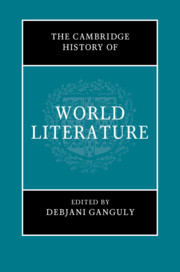Book contents
- The Cambridge History of World Literature
- The Cambridge History of World Literature
- Copyright page
- Contents
- Figures
- Contributors
- Acknowledgements
- Introduction
- Part I Genealogies
- Part II Thinking the World
- Part III Transregional Worlding
- Part IV Cartographic Shifts
- Part V World Literature and Translation
- Part VI Poetics, Genre, Intermediality
- Part VII Scales, Polysystems, Canons
- 36 Spatial Scale and the Urban Everyday: The Physiology as a Traveling Genre (Paris, St. Petersburg, Tiflis)
- 37 Imaginative Geographies in the Medieval Islamic Republic of Letters
- 38 The Anthology as the Canon of World Literature
- 39 Data Worlds: Patterns, Structures, Libraries
- Part VIII Modes of Reading and Circulation
- Part IX The Worldly and the Planetary
- Index
- References
36 - Spatial Scale and the Urban Everyday: The Physiology as a Traveling Genre (Paris, St. Petersburg, Tiflis)
from Part VII - Scales, Polysystems, Canons
Published online by Cambridge University Press: 17 August 2021
- The Cambridge History of World Literature
- The Cambridge History of World Literature
- Copyright page
- Contents
- Figures
- Contributors
- Acknowledgements
- Introduction
- Part I Genealogies
- Part II Thinking the World
- Part III Transregional Worlding
- Part IV Cartographic Shifts
- Part V World Literature and Translation
- Part VI Poetics, Genre, Intermediality
- Part VII Scales, Polysystems, Canons
- 36 Spatial Scale and the Urban Everyday: The Physiology as a Traveling Genre (Paris, St. Petersburg, Tiflis)
- 37 Imaginative Geographies in the Medieval Islamic Republic of Letters
- 38 The Anthology as the Canon of World Literature
- 39 Data Worlds: Patterns, Structures, Libraries
- Part VIII Modes of Reading and Circulation
- Part IX The Worldly and the Planetary
- Index
- References
Summary
World literary studies appears caught between several competing models, each privileging the determining force of a given spatial scale – the global versus the local, national, or regional, - or a specific patterning of space – vertical structure versus horizontal network. This article seeks to test a multiscalar and transregional method of analysis which might place these models in sharper dialogue. It does so by addressing the physiology, a popular quasi-journalistic nineteenth-century genre dedicated to the taxonomic description of mores, customs and social types found in the everyday life of the modern city. Arising in Paris and other metropolises of western Europe, the physiology was soon adapted to the very different circumstances of the Russian capital St. Petersburg, before shifting to the Russian colonial administrative centre of Tiflis (Tbilisi), today the capital of Georgia. This article explores the poetics and cultural politics of the physiology’s adaptation to three distinct urban contexts, in what might be seen as a movement from centre to colonial periphery via the Russian semi-periphery. In doing so it seeks to link genre theory to debates within critical geography on spatial scale, while also entering debates in urban studies and the sociology of culture on metropolitan and peripheral modernization, particularly as it relates to the correlation between the state, the market, and the literary public sphere. Drawing on the work of Henri Lefebvre and Harry Harootunian on the uneven spatio-temporal rhythms of the urban everyday, the article also addresses the limits of such canonical interventions as Walter Benjamin’s critique of the Parisian flâneur and Jürgen Habermas’s account of the bourgeois public sphere.
Keywords
- Type
- Chapter
- Information
- The Cambridge History of World Literature , pp. 693 - 729Publisher: Cambridge University PressPrint publication year: 2021
References
- 1
- Cited by



